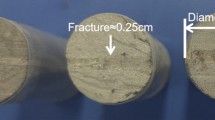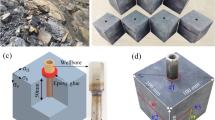Abstract
In shale gas industry, it is desired to develop new reservoir fracturing and enhanced gas recovery technologies to replace the conventional hydraulic fracturing (HF), in order to reduce water usage to guarantee the environmental sustainability and boost individual well production. As the goal of HF is to create high conductivity fracturing networks as flow paths for gas, it is necessary for HF to activate and connect existing natural fractures to generate large fractures network. The success or failure of HF often depends on the stimulated reservoir volume (SRV) which is characterized by the quantity and the quality of the fractures network resulted. This study investigates the micro-fractures network resulted in laboratory HF experiments in 2-D thin polished section by using a fluorescent method supported by advanced computerized image analysis. To evaluate difference of resulted SRV due to the difference of fracturing fluid, using three cylindrical shale cores and three granite cubes having fractures induced by HF using three fluids having different viscosity; oil, water and liquid carbon dioxide (L-CO2). The observation and statistical analysis of fractures induced in HF by the three different fluid viscosities using the fluorescent method showed ability of L-CO2 injection to achieve effective stimulation. The results suggest that employing a low viscosity fluid in HF of shale reservoirs can achieve more productive network with better SRV. In addition, the observation seems to be consistent with the tendency observed in the previous researches.










Similar content being viewed by others
References
Arthur J, Bohm B, Layne M (2008) Hydraulic fracturing considerations for natural gas wells of the Marcellus shale. In: Proceedings of the ground water protection council annual forum, Ohio, USA, pp 1–16
Bennour Z, Ishida T, Nagaya Y, Chen Y, Nara Y, Chen Q, Sekine K, Nagano Y (2015) Crack extension in hydraulic fracturing of shale cores using viscous oil, water and liquid carbon dioxide. Rock Mech Rock Eng 48(4):1463–1473
Chen Y, Suzuki T, Kusuda H, Bennour Z, Tomita K, Nagaya Y, Inui S, Nara Y, Ishida T, Sekine K, Nagano Y, Chen Q, Nakayama Y (2013) Fracture observation of fractures extended by hydraulic fracturing in shale samples. In: Proceedings of the Mining and Material Processing Institute of Japan (MMIJ) Spring Meeting, Tokyo, Japan, pp 69–70
Cipolla C, Warpinski N, Mayerhofer M, Lolon E, Vincent M (2010) The relationship between fracture complexity, reservoir properties, and fracture-treatment design. Soc Pet Eng. doi:10.2118/115769-PA
Clarkson CR, Nobakht M, Kaviani D, Ertekin T (2012) Production analysis of tight-gas and shale-gas reservoirs using the dynamic slippage concept. SPE J 17(1):230–242
Clarkson CR, Solano N, Bustin R, Bustin A, Chalmers G, He L, Melnichenko Y, Radlinski A, Blach T (2013) Pore structure characterization of north American shale gas reservoirs using USANS/SANS, gas adsorption, and mercury intrusion. Fuel 103:606–613
Cnudde V, Boone M (2013) High-resolution X-ray computed tomography in geosciences: a review of the current technology and applications. Earth Sci Rev 123:1–17
Fukuda D, Nara Y, Kobayashi Y, Maruyama M, Koketsu M, Hayashi D, Ogawa H, Kaneko K (2012) Investigation of self-sealing in high-strength and ultra-low-permeability concrete in water using micro-focus X-ray CT. Cem Concr Res 42:1494–1500
Godec M, Koperna G, Petrusak R, Oudinot A (2013) Potential for enhanced gas recovery and CO2 storage in the Marcellus shale in the eastern United States. Int J Coal Geol 118:95–104
Hirono T, Takahashi M, Nakashima S (2003) In situ visualization of fluid flow image within deformed rock by X-ray CT. Eng Geol 70:37–46
Ishida T, Chen Q, Mizuta Y, Roegiers JC (2004) Influence of fluid viscosity on the hydraulic fracturing mechanism. Trans ASME (J Energy Resour Technol) 126:190–200
Ishida T, Aoyagi K, Niwa T, Chen Y, Murata S, Chen Q, Nakayama Y (2012) Acoustic emission monitoring of hydraulic fracturing laboratory experiment with supercritical and liquid CO2. Geophys Res Lett 39:L-16309
Ishida T, Chen Y, Bennour Z, Yamashita H, Inui S, Nagaya Y, Naoi M, Chen Q, Nakayama Y, Nagano Y (2016) Features of CO2 fracturing deduced from acoustic emission and microscopy in laboratory experiments. J Geophys Res Solid Earth. doi:10.1002/2016JB013365
Jia L, Chen M, Sun L, Sun Z, Zhang W, Zhu Q, Sun Z, Jin Y (2013) Experimental study on propagation of hydraulic fracture in volcanic rocks using industrial CT technology. Pet Explor Dev 40(3):405–408
Johns R, Steude J, Castanier L, Roberts P (1993) Nondestructive measurements of fracture aperture in crystalline rock cores using X-ray computed tomography. J Geophys Res 98:1889–1900
Kear J, White J, Bunger AP, Jeffrey R, Hessami MA (2013) Three dimensional forms of closely-spaced hydraulic fractures, chapter 34. In: Bunger AP, McLennan JD, Jeffrey RG (eds) The international conference for effective and sustainable hydraulic fracturing, 20–22 May, Brisbane, Australia
Ketcham R, Carlson W (2001) Acquisition, optimization and interpretation of X-ray computed tomographic imagery: applications to the geosciences. Comput Geosci 27:381–400
Khosrokhavar R, Wolf KH, Bruining H (2014) Sorption of CH4 and CO2 on a carboniferous shale from Belgium using a manometric setup. Int J Coal Geol 128(129):153–161
Liao S, Brunner F, Mattar L (2009) Impact of ignoring CO2 injection volumes on post-frac PTA. In: Canadian international petroleum conference, Petroleum Society of Canada, Calgary, Alberta, Canada
Liu F, Ellett K, Xiao Y, Rupp JA (2013) Assessing the feasibility of CO2 storage in the New Albany Shale (Devonian-Mississippian) with potential enhanced gas recovery using reservoir simulation. Int J Greenh Gas Control 17:111–126
Mayerhofer MJ, Lolon E, Warpinski NR, Cipolla CL, Walser DW, Rightmire CM (2010) What is stimulated reservoir volume? Soc Pet Eng. doi:10.2118/119890-PA
Melzer LS (2012) Carbon dioxide enhanced oil recovery (CO2-EOR): factors involved in adding carbon capture, utilization and storage (CCUS) to enhanced oil recovery. In: Proceedings of the annual CO2 flooding conference, Feb 2012 Midland, Texas, USA
Middleton RS, Carey JW, Currier RP, Hyman JD, Kang Q, Karra S, Jiménez-Martínez J, Porter ML, Viswanathan HS (2015) Shale gas and non-aqueous fracturing fluids: opportunities and challenges for supercritical CO2. J Appl Energy 147:500–509
NETL (2012) Carbon sequestration atlas of the United States and Canada, 4th edn. National Energy Technology Laboratory, U.S. Department of Energy. http://www.netl.doe.gov/technologies/carbonseq/refshelf/atlasIV/Atlas-IV-2012.pdf
Nishiyama T, Kusuda H (1994) Identification of pore spaces and micro cracks using fluorescent resins. Int J Rock Mech Min Sci Geotech 31(4):369–375
Nuttall BC (2010) Reassessment of CO2 sequestration capacity and enhanced gas recovery potential of middle and upper Devonian black shales in the Appalachian basin. MRCSP phase II topical report, Oct 2005–Oct 2010. Kentucky Geological Survey, Lexington, KY, USA
Nuttall BC, Drahovzal JA, Eble CF, Bustin RM (2006) CO2 Sequestration in gas shales of Kentucky. In: 5th annual conference on carbon capture and sequestration, Alexandria, Virginia, Poster No. 106
Peng P, Ling K, He J, Liu Z (2015) Shale gas reservoir treatment by a CO2 based technology. In: Proceedings of 2nd Biennial CO2 for EOR as CCUS conference, Oct 4–6, Houston Texas, USA
Ross DJK, Bustin RM (2009) The importance of shale composition and pore structure upon gas storage potential of shale gas reservoirs. J Mar Pet Geol 26:916–927
Sharma M, Manchanda R (2015) The role of induced un-propped (IU) fractures in unconventional oil and gas wells. Soc Pet Eng. doi:10.2118/174946-MS
Sinal ML, Lancaster G (1987) Liquid CO2 fracturing: advantages and limitations. Can Pet Technol 26(5):26–30
Warpinski N (1996) Hydraulic fracture diagnostics. Soc Pet Eng. doi:10.2118/36361-JPT
Weniger P, Kalkreuth W, Busch A, Krooss BM (2010) High-pressure methane and carbon dioxide sorption on coal and shale samples from the Paraná basin, Brazil. Int J Coal Geol 84:190–205
Yuan W, Pan V, Li X, Yang Y, Zhao C, Connell LD, Li S, He J (2014) Experimental study and modelling of methane adsorption and diffusion in shale. Fuel 117:509–519
Acknowledgements
The authors wish to acknowledge the support of Kushiro Coal Mine Co. Ltd. for providing the shale blocks that were used to prepare the cores for the hydraulic fracturing experiments in this study. The authors also acknowledge the kind support of Professor Hitoshi Mikada and Professor Yoshitaka Nara for their suggestions and comments that helped improving this study.
Author information
Authors and Affiliations
Corresponding author
Rights and permissions
About this article
Cite this article
Bennour, Z., Watanabe, S., Chen, Y. et al. Evaluation of stimulated reservoir volume in laboratory hydraulic fracturing with oil, water and liquid carbon dioxide under microscopy using the fluorescence method. Geomech. Geophys. Geo-energ. Geo-resour. 4, 39–50 (2018). https://doi.org/10.1007/s40948-017-0073-3
Received:
Accepted:
Published:
Issue Date:
DOI: https://doi.org/10.1007/s40948-017-0073-3




